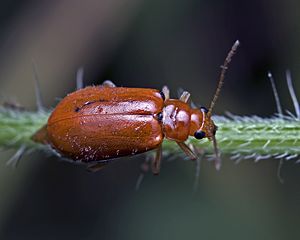Red pumpkin beetle facts for kids
Quick facts for kids Red pumpkin beetle |
|
|---|---|
 |
|
| Scientific classification | |
| Genus: |
Aulacophora
|
| Species: |
foveicollis
|
| Synonyms | |
|
|
The red pumpkin beetle, also known as Aulacophora foveicollis, is a small insect. It belongs to the leaf beetle family. This beetle is a common pest that causes problems for plants. It especially likes plants in the Cucurbitaceae family, like pumpkins. It can also harm millet crops in India.
Contents
What Does It Look Like?
Adult red pumpkin beetles are small. They are about 5 to 8 millimeters (0.2 to 0.3 inches) long. They are about 3.5 millimeters (0.14 inches) wide. Their wing covers, called elytra, can be light orange-yellow to bright orange-red or even medium brown. Their belly is black and covered with soft white hairs.
The young beetles, called grubs, live in the soil. They are thin and creamy-yellow. They have pale brown heads and a pale brown front part of their body (prothorax).
Where Do Red Pumpkin Beetles Live?
A. foveicollis can be found in many places around the world. They live across southern Europe, Asia, Australia, and Africa. They are a big problem for squash and pumpkin crops in northwestern India.
Life Cycle of the Red Pumpkin Beetle
In northern India, these beetles spend the winter sleeping. They wake up and appear in March. After mating, the female beetle lays groups of about eight eggs in the soil. The eggs are orange and oval-shaped. They hatch in one to two weeks.
The young grubs first eat dead leaves, roots, and parts of the host plant that touch the soil. As they grow, they shed their skin four times. Then, they turn into pupae in small dirt rooms just under the soil surface. After another one to two and a half weeks, the adult beetles come out. They climb onto the host plant and start eating. The female beetles start laying eggs about a week later. There can be up to five groups of new beetles born during the summer.
How Do They Affect Plants?
Red pumpkin beetles cause the most damage in March and April. This is when the plants are still small. The adult beetles eat the leaves, buds, and flowers. They can eat so much that the plants lose all their leaves. The grubs dig into the roots and harm the stems and fruits that lie on the soil.
A. foveicollis prefers pumpkin (Cucurbita maxima) more than other plants in the squash family. However, they will also eat squash (Cucurbita pepo), muskmelon (Cucumis melo), cucumber (Cucurbita sativus), watermelon (Citrullus lanatus), and the sponge gourd (Luffa aegyptiaca).
Some plants, like the sponge gourd, have special parts called extrafloral nectaries. These parts make a sweet liquid that attracts ants. In India and much of Southeast Asia, a common ant species is Camponotus compressus. When these ants are on the plant, they can scare away the red pumpkin beetles. This helps protect the plant from damage.
See also
 In Spanish: Aulacophora foveicollis para niños
In Spanish: Aulacophora foveicollis para niños

